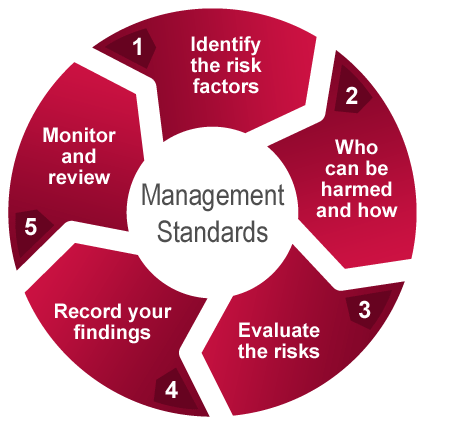HSE Management Standards for Tackling Work-Related Stress
This page provides a summary of what HSE Management Standards are all about and from here you can go to pages where you can download related tools and resources:
Downloads:
HSE Management Standards Indicator Tool, Analysis Tool and Manuals
Other Management Standards' resources (coming soon)
(You have to be a member to download tools and resources from this site. It's easy to apply, just fill in our short membership form.)
What are the Management Standards?
The UK Health & Safety Excutive (HSE) introduced the Management Standards in 2004 to help organisations understand what they need to do to assess and manage the risks to employee wellbeing posed by work-related stress (please note: they don't apply to non-work stressors).
The Management Standards cover 6 known factors that can increase the risk of work-related stress if they are not managed appropriately. They are:
To comply with best practice, HSE recommends that organisations follow the Management Standards Approach, a stress risk assessment process with 5 stages which enables and organisations to identify stress risks and take action to manage those risks. This includes organisational actions.
Downloads:
HSE Management Standards Indicator Tool, Analysis Tool and Manuals
Other Management Standards' resources (coming soon)
(You have to be a member to download tools and resources from this site. It's easy to apply, just fill in our short membership form.)
What are the Management Standards?
The UK Health & Safety Excutive (HSE) introduced the Management Standards in 2004 to help organisations understand what they need to do to assess and manage the risks to employee wellbeing posed by work-related stress (please note: they don't apply to non-work stressors).
The Management Standards cover 6 known factors that can increase the risk of work-related stress if they are not managed appropriately. They are:
- Demands – this includes issues such as workload, work patterns and the work environment.
- Control – how much say the person has in the way they do their work.
- Support – this includes the encouragement, sponsorship and resources provided by the organisation, line management and colleagues.
- Relationships – this includes promoting positive working to avoid conflict and dealing with unacceptable behaviour.
- Role – whether people understand their role within the organisation and whether the organisation ensures that they do not have conflicting roles.
- Change – how organisational change (large or small) is managed and communicated in the organisation.
To comply with best practice, HSE recommends that organisations follow the Management Standards Approach, a stress risk assessment process with 5 stages which enables and organisations to identify stress risks and take action to manage those risks. This includes organisational actions.
The basic idea behind the Management Standards is that, by following the approach, organisations can benchmark where they are currently in terms of managing stress risks (which can be done by surveys or focus groups) and then take steps to improve their stress management performance. For each Standard, there are corresponding 'States to be achieved.
To help with benchmarking, HSE developed a questionnaire tool called the Management Standards Indicator Tool, which organisations can use with surveys. They also developed an Analysis Tool to help analyse the data generated. (Please note: Scotland took this a stage further and developed the Work Positive Tool, an online survey tool, which includes the Management Standards, but also an additional question set looking at wider workplace wellbeing. You don't have to be based in Scotland to use this excellent tool and because it is web enabled you don't have to worry about dealing with the hassle of putting data into spreadsheets.)
To help with benchmarking, HSE developed a questionnaire tool called the Management Standards Indicator Tool, which organisations can use with surveys. They also developed an Analysis Tool to help analyse the data generated. (Please note: Scotland took this a stage further and developed the Work Positive Tool, an online survey tool, which includes the Management Standards, but also an additional question set looking at wider workplace wellbeing. You don't have to be based in Scotland to use this excellent tool and because it is web enabled you don't have to worry about dealing with the hassle of putting data into spreadsheets.)
